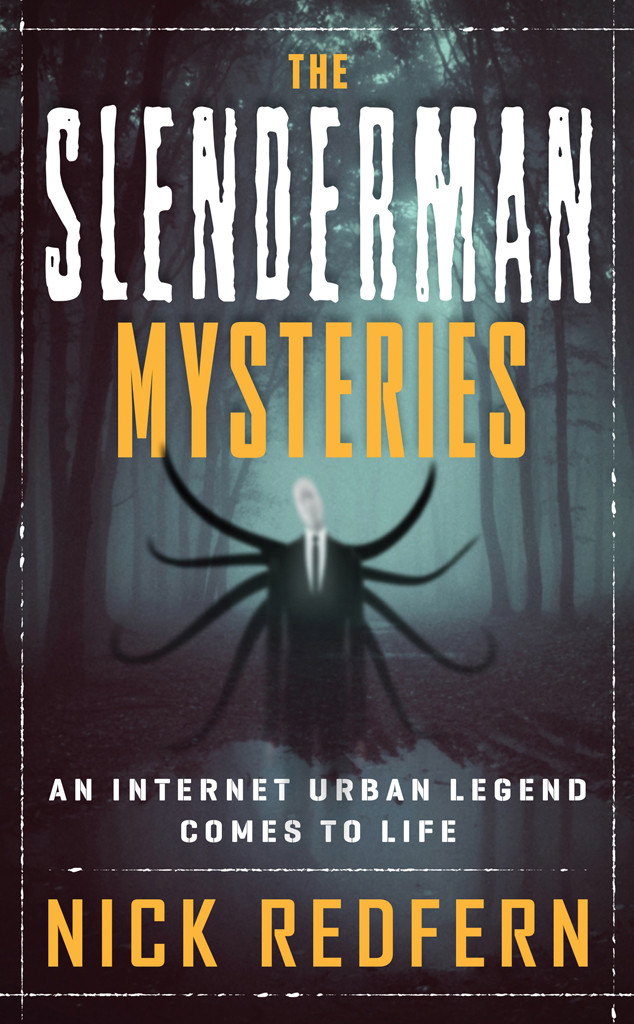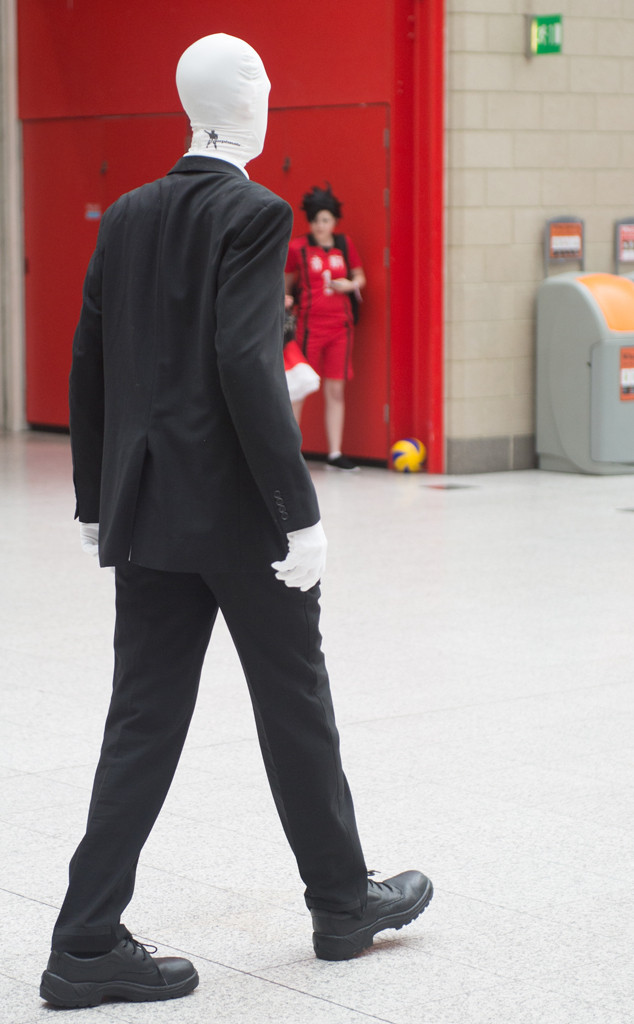Payton Leutner sleeps with a pair of broken scissors under the pillow next to her, “just in case.”
Now 17, the Wisconsin girl who was stabbed five years ago by two fellow 12-year-olds, who insisted they only attacked Payton to please Slender Man, sat down this month to speak out publicly for the first time about the traumatic events that shined a big, scary light on the all-too-real consequences of what can happen when impressionable—or unstable—minds come into contact with a fictional story that’s taken on a life of its own.
Because, obviously, there is no Slender Man—at least, not in the form Morgan Geyser and Anissa Weier thought “he” existed.
“I couldn’t believe it. I couldn’t believe that that kind of thing could have happened,” Payton’s brother Caden Leutner, who was 10 when his sister was attacked, told ABC News’ 20/20. “You hear about that happening to people and you think, ‘That could never happen in my family. That could never happen to me. My sister, my mom, my dad. That would never happen to me. We live in a great neighborhood. We are around great people.’
“But there’s always a chance that that could happen.”
True, the attack didn’t happen in some remote backwater. Payton, Morgan and Anissa lived in Waukesha, a suburb of Milwaukee, the most populous city in Wisconsin. The victim and her attackers all lived comfortably with their families, went to school and did normal things that sixth-graders do, like surf the Web and have sleepovers.
It was the morning after a sleepover at Morgan Geyser’s house on May 31, 2014, after all three girls had visited a skating rink and got frozen yogurt for Geyser’s 12th birthday, that Geyser and Anissa Weier told Payton Leutner they wanted to go to the woods to play. At first they had her lie down while they covered her with leaves and twigs, claiming it was a game of hide-and-seek, and then Geyser proceeded to stab Leutner—her best friend since fourth grade—19 times with a kitchen knife.
“It didn’t feel like anything. It was like… air,” Geyser was later seen telling detectives in the 2017 HBO documentary Beware the Slenderman.
After the other girls had run off, Leutner managed to get up, stabilizing herself by holding onto trees, and made it to the side of the road where a passing bicyclist saw her and called 911. She underwent emergency surgery and for a time she couldn’t talk, so would communicate by writing.
“I want to go home” was her first message, her mom, Stacie Leutner, told Nightline host David Muir.
“Two 12-year-old girls stabbing their friend nearly to death is unimaginable any time, but especially for a safe community like the city of Waukesha,” Police Chief Russell Jack told ABC News at the time.
Geyser and Weier were found about five hours after police were first called. They had blood on their clothes and the knife in a backpack, as well as extra clothes, granola bars and bottles of water—provisions for their journey to where they thought Slender Man might live in Nicolet National Forest. One of the girls also had a photo of her parents and siblings, to remember them by.
Despite defense counsel’s efforts to have the court treat them as juveniles, they were ultimately charged as adults with first-degree intentional homicide—a shocking decision to some observers, considering the girls were only 12.
Weier pleaded guilty in August 2017 to attempted second-degree homicide due to mental illness or defect and was sentenced to at least three years and up to 25 years in a mental health facility. She was 16. In Beware the Slenderman, psychologist Dr. Michael Caldwell said that Weier had schizotypy, which caused “diminished ability to determine what’s real and what’s not real.”
The following February, Geyser was sentenced to 40 years in a mental health facility, with the ability to petition for release.
“Anissa and I took [Payton] into the forest and said we were going to play hide and seek,” an emotional Geyser said in allocuting before the judge in October 2017, when she pleaded guilty to attempted first-degree murder. “Anissa said she couldn’t do it and that I had to. I’m sorry.”
She continued, “I came up from behind [Payton] and jumped on her. I tackled her and I stabbed her with the knife I had taken from my house earlier that morning. Anissa told her to lie down so she wouldn’t lose blood quickly and told her to be quiet and we left.”
Per TMJ 4 News in Milwaukee, Geyser’s lawyers argued that she had been making progress in treatment since 2012, but in sentencing the teen, who was diagnosed with schizophrenia after the attack, Waukesha County Circuit Judge Michael Bohren said, “We can’t forget what we are dealing with. And we can’t forget that this was an attempted murder.”
Addressing the court, including Leutner’s family, Geyser added, “I never meant this to happen. I hope that she is doing well.”
As part of the plea under Wisconsin law, the legal outcomes for both defendants were changed to not guilty by reason of mental disease or defect.
Geyser’s lawyer, Anthony Cotton, called the outcome a “fair resolution.” He acknowledged that some people probably still suspected that his client was faking it, or otherwise feigning crazy to avoid prison, but he said it was important to talk openly about mental health as a physical disease, and stigmatizing such issues only serves to push people further into the shadows, away from getting the help they need.

Waukesha, Wisconsin Police
Leutner told ABC News this month that she never wanted to see either Geyser or Weier again, but if she were to speak to Geyser, she would “probably, initially thank her.”
“I would say,” Leutner explained, “just because of what she did, I have the life I have now. I really, really like it and I have a plan. I didn’t have a plan when I was 12 and now I do because of everything that I went through.”
She’s planning to start college in 2020 and wants to have a career in the medical field.
Leutner also said that she wasn’t surprised when Geyser originally explained her motive, that she thought she was fulfilling Slender Man’s wishes, “because she believed so hard in this thing that she would do anything for it.”
And what was this thing, again, that she believed in?
Slender Man was born on June 10, 2009, when Eric Knudsen of Florida, using the alias “Victor Surge,” uploaded two photos to a forum on the website Something Awful, which had challenged visitors to create an original paranormal image using their Photoshop prowess.
Knudsen came up with an inordinately tall, skinny and faceless man that wore a dark suit and had tentacles, and he Photoshopped the creature into black and white pictures of unnamed kids with captions claiming the photos portrayed “Slender Man” stalking these children.
One caption read: “‘We didn’t want to go, we didn’t want to kill them, but its persistent silence and outstretched arms horrified and comforted us at the same time…’ – 1983, photographer unknown, presumed dead.” The other: “One of two recovered photographs from the Stirling City Library blaze. Notable for being taken the day which fourteen children vanished and for what is referred to as The Slender Man. Deformities cited as film defects by officials. Fire at library occurred one week later. Actual photograph confiscated as evidence. – 1986, photographer: Mary Thomas, missing since June 13th, 1986.”
Within days, other people were playing off of those photos and posting their own Slender Man tales, including purported sightings of the lanky monster, a mythology rising out of thin air.
“I was mostly influenced by H.P Lovecraft, Stephen King (specifically his short stories), the surreal imaginings of William S. Burroughs, and couple games of the survival horror genre; Silent Hill and Resident Evil,” Knudsen (still going by Victor Surge) told a Slender Man blog in 2011, according to Know Your Meme. “I feel the most direct influences were Zack Parsons’s ‘That Insidious Beast,’ the Stephen King short story ‘The Mist,’ the SA tale regarding ‘The Rake,’ reports of so-called shadow people, Mothman, and the Mad Gasser of Mattoon.
“I used these to formulate something whose motivations can barely be comprehended and causes general unease and terror in a general population. The reaction was surprisingly good so I continued making pictures based on Slender Man.”
Knudsen said that he was surprised when he started seeing Slender Man mentions elsewhere online, having figured it would just be a thing for Something Awful, because most urban legends spread via people who have no idea about where a story came from.
“But what is funny is that despite this, it still spread. Internet memes are finicky things and by making something at the right place and time it can swell into an ‘Internet Urban Legend,'” he observed.
Less than two weeks after Knudsen’s first posts, Slender Man went viral on 4chan, the anything-goes message board created in 2003 that later became known for harboring some of the most vile commentary on the Internet.
Art, videos and fiction sprung up in online communities, from the terrifying to the funny, such as when a “cousin” of Slender Man dubbed Trender Man popped up. But for the most part, the cautionary tales of what Slender Man did to his adolescent victims grew more gruesome and graphic.

Weiser
According to RollingStone.com, Slender Man made it to horror and ghost story catch-all site Creepypasta in 2011, taking his place alongside other entirely made up killer ghouls, such as “Killer Jack” and “The Rake.”
Urban legend status achieved.
Anissa Weier was later seen in documentary footage telling detectives, “I was really scared knowing that Slender Man could easily kill my whole family in three seconds.” She also said, “From what I’ve read on the Creepypasta Wiki, it’s easier to kill people when they’re either asleep or unconscious. When you look into a person’s eyes you can see yourself, and you don’t want to be killing yourself. So I asked Bella if she could put herself to sleep.” (Bella being a nickname for Payton.)
After the stabbing, a Creepypasta administrator posted a statement defending the site as a place for make-believe creatures and stories and that they in no way encouraged real-life violence. “There is a line between fiction and reality,” the statement read, “and it is up to you to realize where the line is. We are a literature site, not a crazy satanic cult.”

Ollie Millington/WireImage
Eric Knudsen said in a statement on June 4, 2014, per Rolling Stone, “I am deeply saddened by the tragedy in Wisconsin and my heart goes out to the families of those affected by this terrible act.”
Inevitably, the shock and nightmarish quality of what happened to Payton Leutner in 2014 only fueled mass interest in the macabre Slender Man story, which was promptly adapted for a Law & Order: SVU plot and probed in books and on TV, making the once-fringe meme into a household name. And, of course, around Halloween and at Comic-Con, the ease of putting on a slim-cut suit and disguising one’s face made for a handy costume.
In Beware the Slenderman, Geyser’s mom said that the family started to suspect that Morgan lacked empathy at an early age when they showed her Bambi for the first time.
“We were so worried to watch it with her because we thought she was gonna be so upset when the mother died,” Angie Geyser said in the film. “But the mother died and Morgan just said, ‘Run, Bambi run. Get out of there. Save yourself.’ She wasn’t sad about it.”

Michael Sears/Milwaukee Journal Sentinel/TNS
Weier, meanwhile, left disturbing comments online, such as in February 2014 when she reacted to a video with, “Why did the baby cross the road? BECAUSE IT WAS STRAPPED TO MY BUMPER!!!!”
Parents of both girls said that Morgan and Anissa had mentioned Slender Man to them, and while they didn’t love that their daughters were that into a horror character, their interest didn’t raise any red flags.
“We never thought for a moment that she could possibly believe that it was real,” Angie Geyser said.
Payton Leutner told ABC News’ David Muir for 20/20 that Geyser had told her all about Slender Man and Leutner “thought it was odd. It kind of frightened me a little bit. But I went along with it. I was supportive because I thought that’s what she liked.” But ultimately, it freaked Leutner out, enough so that she checked with her own mom to make sure he wasn’t real.
At the same time, Geyser had become friendly with Weier, whose family lived in the same apartment complex, and as they got closer, the obsession with Slender Man grew.
“I just hung out with [Anissa] because I knew that Morgan really loved her as a friend. But she was always cruel to me,” Leutner told Muir. “I feel like she was jealous that Morgan was friends with me and her.”
Weier told authorities that Geyser came up with the idea to kill Leutner in order to impress Slender Man, who in return would perhaps grant them access to Slender Mansion (because of course he acquired a lair over the course of five whole years online), but Weier was “kind of excited” by the idea. Geyser said, meanwhile, that Weier came up with so many murderous scenarios that she wasn’t sure what they had agreed upon.
“The girls were laughing and having a good time,” Angie remembered the night of the sleepover. “And they asked if they could go to the park, and I didn’t think anything of it.”

Michael Sears/Milwaukee Journal Sentinel/TNS
Beware the Slenderman director Irene Taylor Brodsky told Rolling Stone in 2017 that she was shocked that Geyser and Weier were being treated as adults in the eyes of the law.
“[The judge] was not allowing their age to be a mitigating factor and that was incredibly difficult for me as a human being to witness,” she said. “They’re children.”
Having been following the case since the beginning, Brodsky (who had been researching the effect of online content on pre-adolescent brains when the attack happened) explained, “What I came to discover in the course of making the film, I think the jury in Anissa’s case came to discover: These girls were losing their minds in the narrative that was Slender Man. You can’t say Slender Man made them crazy, but most kids don’t watch Slender Man and go out and kill somebody. You have to look at this through the prism of their mental illness.”

HBO
Added neurodevelopmental psychologist Abigail Baird, who was also interviewed for Brodsky’s film, “The girls were prepubescent at the time of the attack, which added another layer of immaturity. They were just old enough to feel like they had to have friends, but they were young enough to believe in Santa Claus. I can’t get my mind around trying 12 year olds as adults.”
But it was a perfect storm of circumstances that led to what happened, rather than any one thing, including the mere existence of “Slender Man.”
“People try to say that movies and music make people do violent things, but it doesn’t work that way,” Baird told RS. “People who are prone to violent acts feel validated by violent music and movies, so they will look for validation in those worlds. These girls were drawn to Slender Man.”
“We try to visit at least once a week,” Angie Geyser told ABC News last year, on her way to see Morgan at Winnebago Mental Health Institute near Oshkosh, Wis. “On a good week I can get up there two or three times.”
Taking her own car ride, Anissa’s mom, Kristi Weier, said, “Most children are only up there for an average of four months. There are no windows in the facility. In the last 35 months, Anissa’s maybe had 40 hours of fresh air…when the incident happened in May of 2014, Anissa was actually sent to the Washington County Juvenile Detention Facility.”
When she visited her daughter, Kristi continued, “the visiting area is a cement table and a piece of glass and we can see each other, but we can’t touch her. I can’t wipe away a tear, I can’t give her a hug, I can’t kiss her.”
As for Payton Leutner, she and her family are lucky to be pressing on all together.
“I’ve come to accept all of the scars that I have,” Leutner told David Muir for 20/20. “It’s just a part of me. I don’t think much of [Morgan and Anissa]. They will probably go away and fade eventually.”
Her attackers’ stories have been told time and again, as has Slender Man’s. “I feel like it’s time for people to see my side rather than everyone else’s,” Leutner said.
